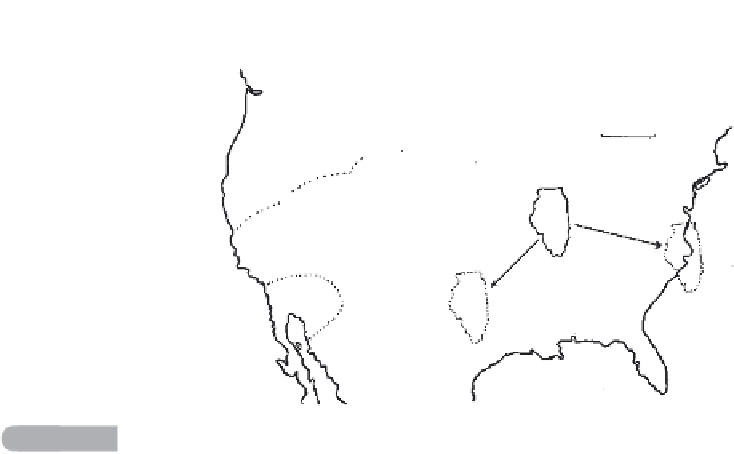Geoscience Reference
In-Depth Information
480 km
More arid
2090
2090
Wetter
Hadley model
2090
Canadian model
2090
Fig. 6.4
Diicultiesinpredicting21st-centurychangeintheUSA,inthiscasebytheHadleyandCanadianclimate
models(NationalAssessmentSynthesisTeam,2001).BothmodelssuggestedthatsouthernCaliforniawould
becomewetterandthatpartsaroundColoradoandKansaswouldbecomedrier.However,diferencesbetween
themodelsincludewhetherIllinois'sclimatewillbecomelikeNorthandSouthCarolina'sorlikeOklahoma's.
cooled. With regards to the 21st century, both the Canadian and the Hadley models
agreed that the USA would warm up but disagreed as to the exact intensity of this
warming on a state-by-state basis. The Canadian model predicted warming across the
USA but with a large centre of stronger warming in the central states of South Dakota,
Wyoming and Nebraska. Conversely, the Hadley model predicted an almost similar,
but marginally milder, background of warming compared to the Canadian model,
without a central island of stronger warming and with slightly milder warming of the
south-eastern states around Florida, Alabama, Georgia and North and South Carolina.
Although computer models have improved since then, model improvement is still an
ongoing enterprise and likely to be so for decades to come. So it is perhaps worth
noting (as we shall shortly see, hence Figure 6.4) some of the areas of debate and
uncertainty as to computer model output at the beginning of the 21st century, because
the issues then are more or less the same as the issues now, only starker: subsequent
model improvement has, and will, reduce uncertainty and provide additional detail.
With regards to changes in precipitation, the 2001 USGCRP report again presented
outputs from both the Canadian and Hadley models. These suggest that much of the
USA will see an increase in precipitation of 20-40% and that California (especially
southern California) might experience more than this. However, they differed in that
the Canadian model attributed far more rainfall to the states to the east of California
and also up to 20% less rain in the central and eastern-seaboard states. Of course, as
previously noted, increased rainfall does not necessarily mean more water for plants.
If evaporation due to a temperature rise is more than the extra rainfall then soils
become drier. Both models forecast that the area around the Colorado/Oklahoma
border will experience a decline in soil moisture and that in California there will be
an increase. Other than this, the models gave contrasting forecasts. With reference
to the medieval climatic anomaly (MCA; see Chapter 4) being an analogue to a
degree or so of medium-term future climatic warming that we would expect, only

Search WWH ::

Custom Search